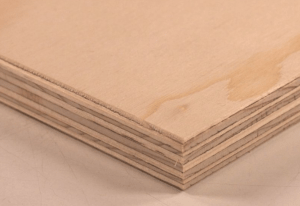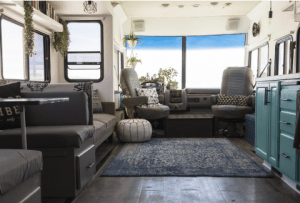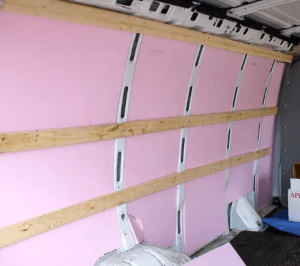What are RV Interior Walls Made of?
RV interior walls could be from several different materials including:
- Composite Plywood – this is basically compressed sheets of hardwood
- Vinyl – a special kind of plastic that is hard and durable and it’s becoming increasingly popular
- MDF – stands for Medium Density Floorboard. It’s a fancy term for a type of cheap wood siding and is very similar to plywood.
If you want to learn more, here’s a full guide on interior wall materials and why you should choose them. Take a look.
Table of Contents
What RV Interior Wall Material is Most Used?
RV walls can be from several materials, including:
Composite Plywood

Pros:
- Durable – The main benefit of using plywood is that it’s relatively stable and resists impact damage. Since it is several sheets compressed together, it’s got a lot of tensile strength. It won’t break or bend easily and certainly won’t dent when you hit it.
- Beauty – Plywood looks gorgeous and makes your RV or camper feel like your typical home. Compare that to the ugly aluminum walls in most RVs, and you’ll get what we’re talking about.
Cons:
- Subject to Water Damage – Plywood cannot resist water damage, much like most other wood forms. It’s not exactly as hard as other woods and will soak up the water and swell up quickly.
- Might Weaken over Time – Water damage can lead to a host of different problems. Depending on how you’ve set your walls, softening of the interior walls may threaten their integrity. Your RV could collapse, and you could get injured.
Vinyl

Pros:
- Easy to Cut – You can easily cut the vinyl using a simple box-cutter and can shape the panels however you like.
- Cheap Installation – It’s cheap to install, mainly because you don’t even require a professional.
- Versatile Design – Newer vinyl panel designs can look like wood, marble, and other surfaces. So, you don’t have to bear the pain of an unnatural-looking interior wall.
Cons:
- Not Very Durable – One downside is, it’s not as durable as it may seem. This shouldn’t be an issue since you can replace it easily. And it’s cheap, so you don’t have to worry about repair costs. But having to go through the pain of doing so can put some people off.
- Easily Dented – Another reason you might not like vinyl is that it can be easily dented. The material is quite soft, so it doesn’t hold up against impact. Also, it’s not a good contender for the cold weather. So, if you’re camping out in the snow, then either get some good insulation or ditch the vinyl.
MDF

Pros:
- Cheaper – Since it’s from sawdust, it’s less expensive than composite plywood. So, if you wanted a genuine wooden interior but didn’t have enough money, then consider MDF.
- Design Choice – MDF is not as strong as actual plywood. But it holds up better than vinyl or aluminum. Since the top layer is veneer, you can choose the design you like and not be bound by any limitations. You might even get it laminated.
Cons:
- Weaker than Plywood – Because the only thing keeping it together is glue, it’s not a strong contender. It trumps in durability compared to composite plywood. You might try to strengthen the exterior by laminating it, but it can only hold up for so long.
Why are Interior Walls Important?
So you know what types of interior walls you can opt for. But why should you? Here are a few reasons you might want an interior wall:
Interior Design

Renovating the interior will help bring out the best in your RV. If your RV has an old-fashioned aluminum interior, replacing it with a more natural-looking wooden surface will work best. After all, it’s your RV. So, you’ve got to personalize it.
If you don’t like the wooden pattern, then you can always choose a decent wallpaper. But wallpapers won’t apply to every surface easily. They fit best on vinyl or laminate surfaces.
Extra Insulation

You might want to look into interior walls as extra insulation if you’re camping in the winter. Particularly, if you’re going somewhere chilly, then you’ll wish for extra insulation. You can even insulate the interior wall to block any heat flow in and out of the room.
Soundproofing

Now there aren’t many soundproofing options out there if you don’t want to renovate the exterior wall. But you could go one layer deeper and replace your current insulation with soundproof insulation. You can also “pump” it into the wall via a special device that requires you to drill a hole into the wall.
You’ll want to soundproof your walls to prevent vibrations and loud noises from penetrating the room.
Conclusion
Renovating your travel trailer can be fun and exciting. It shouldn’t have to be a burden on your body or your finance. It only makes sense that you make an informed decision instead of regretting it later.
Travel trailers come manufactured with an interior wall, but if you want to personalize it, you have many options at your disposal. Choose composite plywood if you’re looking for durability. If you’re low on the budget, then try MDF. And if you want a gorgeous wall that’s easy to paste wallpapers on, then try your luck with vinyl.
So, make the right choice today and personalize your motor home!

I`m a current Law Enforcement Officer working within the Counterterrorism Bureau in New York State. I have been Camping for over 20 years. My styles of camping include tent, car, truck, van, and RV travel trailer. I have a YouTube channel where I teach all types of camping with an entertaining method: https://youtube.com/@TheSmallsRVAdventures






